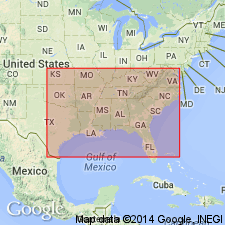
- Usage in publication:
-
- Meridian formation
- Meridian buhrstone
- Modifications:
-
- Original reference
- Dominant lithology:
-
- Limestone
- Sandstone
- Shale
- Marble
- AAPG geologic province:
-
- Mid-Gulf Coast basin
Summary:
Pg. 413-415, 491+. The most distinctive rock mass of Mississippi embayment. It is as characteristic and distinctive as limestone, sandstone, shale, or marble; but by reason of its confinement to a comparatively restricted region it has never received the coordinate appellation it deserves. Is typically displayed in vicinity of Meridian; from these exposures it seems appropriate to designate the deposit Meridian formation; or, if the general though unsatisfactory lithologic term be retained, Meridian buhrstone. Here it comprises hard siliceous ledges, with intercalated beds of imperfectly indurated siliceous clay or marl, the mass displaying moderately regular bedding; yet despite a high degree of uniformity in composition and structure there is wide diversity in texture, owing to variable degree of lithification. There is commonly a rude nodulation or segregation of materials in plates and lenses, variously disposed in attitude; the nodules, plates, and lenses are generally hard, brittle, refractory under the hammer, clinking sharply and breaking with conchoidal or splintery fracture, while intervening mass is less perfectly lithified, and sometimes quite friable. Sometimes nodules are an inch or less in diameter, the plates and lenses but hand specimens; again the harder aggregations measure feet or yards, the nodules running into lenses which expand into ridges. Is middle Eocene. Underlies calcareous Claiborne.
[Named from development in vicinity of Meridian, Lauderdale Co., southeastern MS.]
Source: US geologic names lexicon (USGS Bull. 896, p. 1351).

- Usage in publication:
-
- Meridian formation†
- Meridian buhrstone†
- Modifications:
-
- Abandoned
- AAPG geologic province:
-
- Mid-Gulf Coast basin
Summary:
†Meridian formation or †Meridian buhrstone of southeastern Mississippi and southern Alabama replaced by Tallahatta formation, a later but better-established name. Preoccupied by Rogers' †Meridian series of Pennsylvania. See additional explanation under †Choctaw buhrstone.
Source: US geologic names lexicon (USGS Bull. 896, p. 1351).

- Usage in publication:
-
- Meridian formation
- Modifications:
-
- Areal extent
- AAPG geologic province:
-
- Mid-Gulf Coast basin
Summary:
Pg. 14-18. Meridian formation. Described in Yalobusha County, southeastern Mississippi, where it is 40 to 125 feet thick. Unconformably overlies Ackerman formation; contact with overlying Tallahatta not well defined as Meridian sand is interlensed with Tallahatta sand and shale. In basal part of Claiborne. [Age is middle Eocene.]
Source: US geologic names lexicon (USGS Bull. 1200, p. 2469).
For more information, please contact Nancy Stamm, Geologic Names Committee Secretary.
Asterisk (*) indicates published by U.S. Geological Survey authors.
"No current usage" (†) implies that a name has been abandoned or has fallen into disuse. Former usage and, if known, replacement name given in parentheses ( ).
Slash (/) indicates name conflicts with nomenclatural guidelines (CSN, 1933; ACSN, 1961, 1970; NACSN, 1983, 2005, 2021). May be explained within brackets ([ ]).

